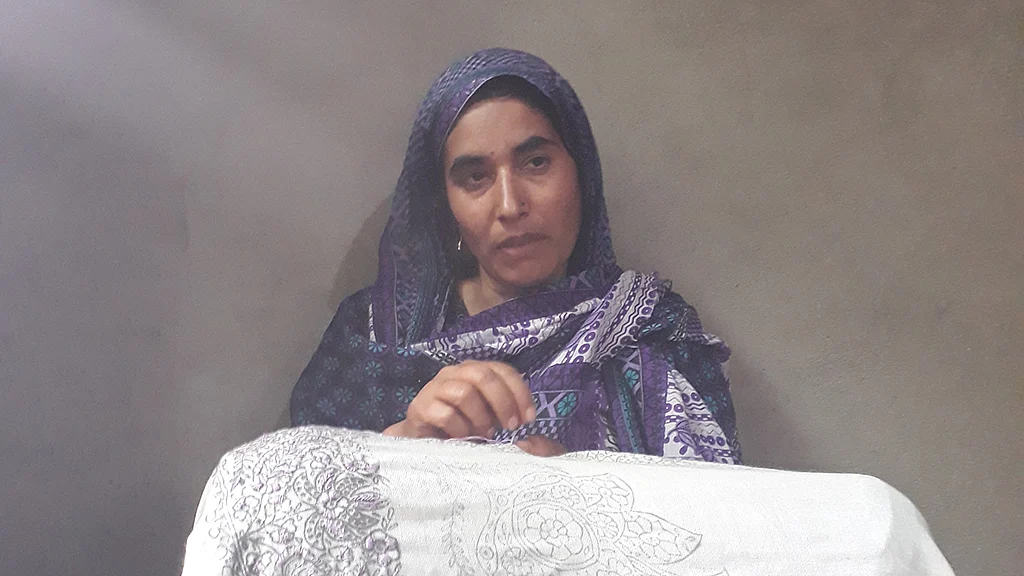Kashmir’s “forced disappearances”: A half-widow in Baramulla still awaits the return of her husband
As family members of victims of forced disappearances held a peaceful demonstration in Srinagar, a National Herald reporter travelled to a village in Baramulla to know the tale of a half-widow

A narrow road towards the left of Magam town along the Srinagar-Gulmarg highway serpentines through the apple orchards, leading to the sparsely populated village of Larkipora in Baramulla district. A loud and continuous yapping of a sleek and sturdy canine welcomes outsiders to the village. Just a few doors down the village street, stands the single-story house of Zaina.
Zaina (40) leads the life of a half-widow ever since her husband Abdul Rashid Parra, then 27, went missing after being allegedly picked up by the Army. On November 16, 2002, Parra—as Zaina recounts— went to work in his apple orchard nearby. A few hours later, three military vehicles pulled into the road at his orchard, and within a few minutes, the Army men bundled him into a vehicle and left.
“When he did not return till late, I, along with some neighbors, went to the orchard, leaving my two children alone at home. As we couldn’t find him, a neighbour in the village informed us that he saw some Army men forcing him into their vehicle,” she recalls.
Next day, Zaina registered an FIR with the Kunzer police station and started searching for him in Army camps located in the area. She, along with some relatives, called on many political leaders, including the local MLA, to seek help in finding her husband. However, she got nothing other than words of hope.
Parra would do the needlework to eke out a living and had no connections with any militant outfit. In his village, Parra was known for sewing wonderful designs on shawls. Zaina sometimes used to assist him in his work.
After his disappearance, life threw new challenges at Zaina. She had to feed her children, besides searching for her husband.
“My husband had taught me how to sew designs on shawls. After his disappearance, I took to embroidery to make ends meet,” says Zaina.
Zaina had completed embroidering her first shawl the day his husband went missing. She said her husband was working on the same shawl but disappeared before he could complete it.
“It was my responsibility to complete his unfinished work. With meticulous care, I stitched designs on it and hemmed its borders,” recalls Zaina.
Zaina says that she caressed the shawl a dozen times—before she handed it over to the customer—as it carried the last design stitched by her husband.
Zaina works tirelessly to ensure food and education for her children—Tajamul (17) and Tawseef (15). Embroidery fetches her Rs 200-2,500 per month, if she is able to embroider at least four shawls. The few apple trees standing in her tiny orchard have failed to bear fruits ever since her husband went missing, as there was no one to look after them.
As the government is yet to come up with a rehabilitation scheme for the families of victims of “forced disappearances,” it is the Association of Parents of Disappeared Persons (APDP), a non-governmental organisation, which chipped in to provide some financial assistance to Zaina.
“APDP is the only organisation that has helped me so far. It paid the school fees of my children,” says Zaina.
After a few months of her husband’s disappearance, an Army officer—during one of her visits to the nearby Khag Army camp — told Zaina to stop searching for her husband as she wouldn’t be able to find him. Zaina took his word as a hint that her husband had been killed.
After a few days of Parra’s disappearance, a gun battle broke out in the forests of Baramulla and the Army claimed that it had killed a few “foreign” militants without ascertaining their identity. Zaina doubted that her husband was among those killed and had been labeled as an unidentified “foreign militant.”
“During those days, security forces had no qualms about killing people in staged encounters and branding them as unidentified militants. I am not sure but I suspect that he was killed in the same encounter. An encounter, I remember, took place after a few days of his disappearance in the forests of Baramulla,” said Zaina.
According to APDP, affiliated with Jammu and Kashmir Coalition of Civil Societies, there are around 8,000 cases of “forced disappearances” in Kashmir. The Special Investigation Team (SIT) of State Human Rights Commission in 2011 had confirmed that at least 2,156 bodies were lying in unmarked graves across three districts of the Valley.
Although Zaina is still not sure if her husband is dead, she dreams of his return as she continues stitching beautiful designs on shawls.
Follow us on: Facebook, Twitter, Google News, Instagram
Join our official telegram channel (@nationalherald) and stay updated with the latest headlines
